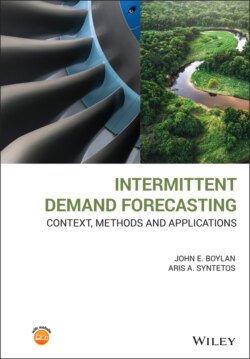Читать книгу Intermittent Demand Forecasting - John E. Boylan - Страница 94
Note 3.1 Fill Rate Expression of Zhang and Zhang
ОглавлениеZhang and Zhang (2007) gave a formal mathematical justification for their measure. Here, we give a more informal explanation. Zhang and Zhang's fill rate measure for periodic review systems with review interval R, and OUT level S, is given in Eq. (3.5).
(3.5)
where , denotes possible total demand values over the periods up to , and denotes possible demand values in the next period, .
The amount subtracted from 1 represents the proportion of demand that is not satisfied. The denominator represents the average demand over the whole review interval (length ), recalling that is the average demand per unit time period.
In the numerator, each unit of time in the review interval is analysed separately. For the first unit of time, denoted by in Eq. (3.5), backorders are generated if the demand is in excess of the remaining stock, after taking into account the cumulative demand over periods, . The same argument applies for the second unit of time, denoted by : backorders are generated if the demand is in excess of the remaining stock, after taking into account the cumulative demand over periods, . This argument holds for every unit of time in the review interval. In each case, the backorders are weighted by the probability of demand in the unit of time and the probability of cumulative demand in the preceding periods, and are summed appropriately. The results are totalled over the whole review interval to give the expected total backorders.
